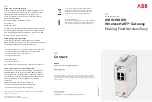
78
MultiVOIP User Guide
Circuit switching: The temporary connection of two or more communications channels using a fixed, non-shareable path through the
network. Users have full use of the circuit until the connection is terminated.
Clear Channel: A transmission path where the full bandwidth is used (i.e., no bandwidth needed for signaling, carrier framing or control
bits). A 64K bps digital circuit usually has 8K bps used for signaling. ISDN has two 64K bps circuits, and a 16K bps packet service of which
part is used for signaling on the 64K channels.
Client-Server: In TCP/IP, the model of interaction in distributed data processing in which a program at one site sends a request to a program
at another site and awaits a response. The requesting program is called a client; the answering program is called a server.
Cluster Controller: A device that can control the input/output operations of more than one device connected to it. A cluster controller may
be controlled by a program stored and executed in the unit, or it may be entirely controlled by hardware.
Committed Burst Size: the maximum number of bits that the frame relay network agrees to transfer during any measurement interval
Committed Information Rate (CIR): An agreement a customer makes to use a certain minimum data transmission rate (in bps). The CIR is
part of the frame relay service monthly billing, along with actual usage, that users pay to their frame relay service provider.
Compression: 1. The process of eliminating gaps, empty fields, redundancies, and unnecessary data to shorten the length of records or
blocks. 2. In SNA, the replacement of a string of up to 64-repeated characters by an encoded control byte to reduce the length of the data
stream to the LU-LU session partner. The encoded control byte is followed by the character that was repeated (unless that character is the
prime compression character). 3. In Data Facility Hierarchical Storage Manager, the process of moving data instead of allocated space
during migration and recall in order to release unused space. 4. Contrast with decompression.
COMx Port: A serial communications port on a PC.
congestion: A network condition where there is too much data traffic. The ITU I.233 standard defines congestion management in terms of
speed and burstiness.
congestion notification: The function in frame relay that ensures that userdata transmitted at a rate higher than the CIR are allowed to
slow down to the rate of the available network bandwidth.
Consecutive Severely Errored Seconds (CSES): An error condition that occurs when from 3 to 9 SES (Severely Errored Seconds) are
logged consecutively.
Customer Premise Equipment (CPE): The generic term for data comm and/or terminal equipment that resides at the user site and is
owned by the user with the following exclusions: Over voltage protection equipment, inside wiring, coin operated or pay telephones, "com-
pany-official" equipment, mobile telephone equipment, "911" equipment, equipment necessary for the provision of communications for
national defense, or multiplexing equipment used to deliver multiple channels to the customer.
D
D4: the T1 4th generation channel bank.
D4 channelization: Refers to the compliance with AT&T TR 62411 for DS1 frame layout.
D4 framing: The T1 format for framing in AT&T D-Series channel banks, in which there are 12 separate 193-bit frames in a super-frame. A
D4 framing bit is used to identify the channel and the signaling frame. Signalling for voice channels is carried in-band for every channel, along
with the encoded voice. See "robbed-bit signaling".
Data Communications Equipment (DCE): Any device which serves as the portal of entry from the user equipment to a telecommunications
facility. A modem is a DCE for the telephone network (PSTN) that is commonly on site at the user’s premises. Packet Switched Networks
have another level of DCE which is most often located at a central office.
Data Link Connection Identifier (DLCI): One of the six components of a frame relay frame. Its purpose is to distinguish separate virtual
circuits across each access connection. Data coming into a frame relay node is thus allowed to be sent across the interface to the specified
"address". The DLCI is confirmed and relayed to its destination, or if the specification is in error, the frame is discarded.
Dataphone Digital Service (DDS): A private line digital service that offers 2400, 4800, 9600 and 56K bps data rates on an inter-LATA basis
by AT&T and on an intra-LATA basis by the BOCs.
Data Service Unit (DSU): A device that provides a digital data service interface directly to the data terminal equipment. The DSU provides
loop equalization, remote and local testing capabilities, and a standard EIA/CCITT interface.
Dedicated Line: A communication line that is not switched. The term leased line is more common.
Default: This is a preset value or option in software packages, or in hardware configuration, that is used unless you specify otherwise.
Device driver: Software that controls how a computer communicates with a device, such as a printer or mouse.
Digital Cross-connect System (DCS): The CO device which splits and redistributes the T1 bandwidth. the DCS takes time slots from
various T1 lines and alters them to provide the needed connectivity. DCS connections are made with software at an administrator's worksta-
tion.
Digital Data: Information represented by discrete values or conditions (contrast "Analog Data").
Summary of Contents for MultiVOIP 400
Page 1: ...Standalone Voice IP Gateway Models MVP400 and MVP 800 User Guide...
Page 5: ...Chapter 1 Introduction and Description...
Page 14: ...14 MultiVOIP User Guide...
Page 15: ...Chapter 2 Installation...
Page 20: ...20 MultiVOIP User Guide...
Page 21: ...Chapter 3 Software Loading and Configuration...
Page 39: ...Chapter 4 MultiVOIP Software...
Page 53: ...Chapter 5 Remote Configuration and Management...
Page 61: ...Chapter 6 Warranty Service and Tech Support...
Page 66: ...66 MultiVOIP User Guide...
Page 67: ...Appendixes...
Page 75: ...Glossary...











































